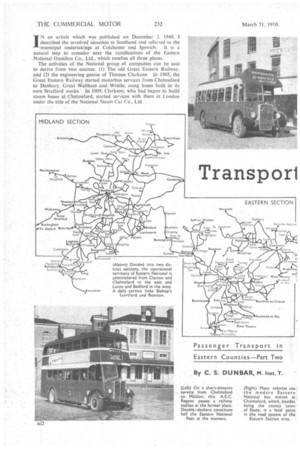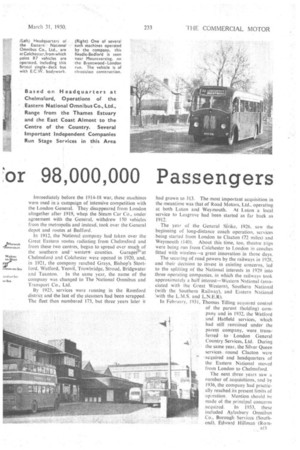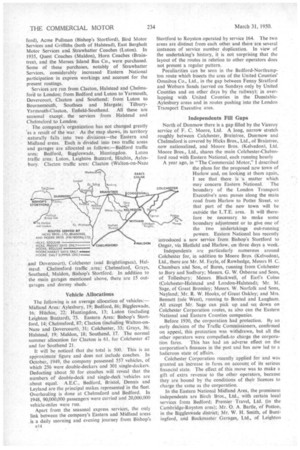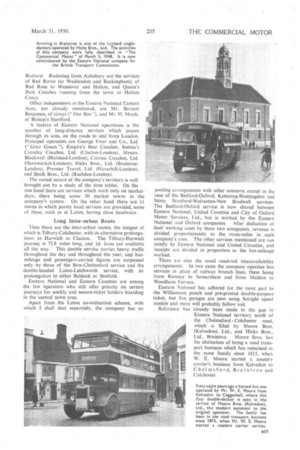Transp on or 98,000,000 Passengers
Page 46

Page 47

Page 48

Page 49

Page 50

If you've noticed an error in this article please click here to report it so we can fix it.
IN an article which was published on December 2, 1949. I described the involved situation in Southend and referred to the
municipal undertakings at Colchester and Ipswich. It is a natural step to consider next the ramifications of the Eastern National Omnibus Co., Ltd., which touches all three places.
The activities of the National group of companies can be said to derive from two sources: (1) The old Great Eastern Railway. and (2) the engineering genius of Thomas Clarkson. In 1905, the Great Eastern Railway started motorbus services from Chelmsford to Danbury, Great Waltham and .Writtle, using buses built in its own Stratford works. In 1909, Clarkson, who had begun to build steam buses at Chelmsford, started services with them in London under the title of the National Steam Car Co., Ltd Immediately before the 1914-18 war, these machines were used in a campaign of intensive competition with the London General. They disappeared from London altogether after 1919, when the Steam Car Co., under agreement with the General, withdrew 150 vehicles from the metropolis and instead, took over the General depot and routes at Bedford.
In 1912, the National company had taken over the Great Eastern routes radiating from Chelmsford and from these two centres, began to spread over muctLof the southern and western counties. Garages at Chelmsford and Colchester were opened in 1920, and, in 1921, the company reached Grays, Bishop's Stortford, Watford, Yeovil, Trowbridge, Stroud, Bridgwater and Taunton. In the same year, the name of the company was changed to The National Omnibus and Transport Co., Ltd.
By 1923, services were running in the Romford district and the last of the steamers had been scrapped. The fleet then numbered 173, but three years later it
had grown to 313. The most important acquisition in the meantime was that of Road Motors, Ltd.. operating at both Luton and Weymouth. At Luton a local service to Leagrave had been started as far back as 1912.
The year of the Genera! Sfrike, 1926, saw the beginning of long-distance coach operation, services being started from London to Clacton (72 miles) and Weymouth (140). About this time, too, theatre trips were being run from Colchester to London in coaches fitted with wireless—a great innovation in those days.
The securing of road powers by the railways in 1928, and their decision to invest in existing concerns, led to the splitting of the National interests in 1929 into three operating companies, in which the railways took approximately a half interest—Western National (associated with the Great Western), Southern National (with the Southern Railway), and Eastern National with the L.M.S. and L.N.E.R).
In February. 1931, Thomas Tilling acquired control of the parent (holding) com pany and in 1932. the Watford and Hatfield services, which had still remained under the parent company, were transferred to London General Country Services, Ltd. During the same year, the Silver Queen services round Clacton were 'acquired and headquarters of the Eastern National moved from London to Chelmsford.
The next three years saw a number of acquisitions, and by 1936, the company had practically reached,its present limits of operation. Mention should he made ot the principal concerns acquired. In 1933, these included Aylesbury Omnibus Co., Borough Services (So ut h • end), Edward Hillman (Rom_ n 13
ford), Acme Pullman (Bishop's Stortford), Bird Motor Services and Griffiths (both of Halstead), East Berghoit Motor Services and Strawhatter Coaches (Luton). In 1935, Quest Coaches (Maldon), Horn Coaches (Braintree), and the Mersea Island Bus Co., were purchased. Some of these purchases, notably of Strawhatter Services, considerably increased Eastern National participation in express workings and account for the present routings.
Services are run from Clacton, Halstead and Chelmsford to London; from Bedford and Luton to Yarmouth, Dovercourt, Clacton and Southend; from Luton to Bournemouth, Southsea and Margate; TilburyYarmouth-Clacton, Enfield-Southend. All these are seasonal except the services from Halstead and Chelmsford to London: The company's organization has not changed greatly as a result of the war. As the map shows, its territory naturally falls into two divisions—the Eastern and Midland areas. Each is divided into two traffic areas and garages are allocated as follows:—Bedford traffic area: Bedford, Biggleswade, Huntingdon. Luton traffic area: Luton, Leighton Buzzard, Hitchin, Aylesbury. Clacton traffic area: Clacton (Walton-on-Naze
and Dovercourt), Colchester (and Brightlingsea), Halstead. Chelmsford traffic area: Chelmsford, Grays, Southend, Maldon, Bishop's Stanford. In addition to the main garages mentioned above, there are 15 outgarages and dormy sheds.
Vehicle Allocations The following is an average allocation of vehicles:— Midland Area: Aylesbury, 19; Bedford, 86; Biggleswade, 16; Hitchin, 22; Huntingdon, 13; Luton (including Leighton Buzzard), 73. Eastern Area: Bishop's Stortford, 14; Chelmsford, 87; Clacton (including Walton-onNaze and Dovercourt), 31; Colchester, 33; Grays, 36; Halstead, 19; Maldon, 18; Southend, 17. The normal summer allocation for Clacton is 61. for Colchester 47 and for Southend 21.
It will be noticed that the total is 500. This is an approximate figure and does not include coaches. In October, 1949, the company possessed 557 vehicles, of which 256 were double-deckers and 301 single-deckers. Deducting about 50 for coaches will reveal that the numbers of double-deck and single-deck vehicles are about equal. A.E.C., Bedford, Bristol, Dennis and Leyland are the principal makes represented in the fleet. Overhauling is done at Chelmsford and Bedford. In 1948, 90,000,000 passengers were carried and 20,000,000 vehicle-miles were run.
Apart from the seasonal express services, the only link between the company's Eastern and Midland areas is a daily morning and evening journey from Bishop's nt4 Stortford to Royston operated by service 164. The two areas are distinct from each other and there are several instances of service number duplication. In view of the undertaking's history, it is not surprising that the layout of the routes in relation to other operators does not present a regular pattern.
Peculiarities can be seen in the Bedford-Northampton route which bisects the area of the United Counties' Omnibus Co., Ltd., in the gap between Fenny Stratford and Woburn Sands (served on Sundays only by United Counties and on other days by the railway); in overlapping with United Counties in the DunstableAylesbury areas and in routes pushing into the London Transport Executive area.
Independents Fill Gaps North of Dunmow there is a gap filled by the Viceroy service of F. C. Moore, Ltd. A long, narrow stretch roughly between Colchester, Braintree, Dunmow and Chelmsford is covered by Hicks Bros., Ltd., of Braintree, now nationalized, and Moore Bros. (Kelvedon), Ltd. Moore Bros., Ltd., shares the main Colchester-Chelmsford road with Eastern National, each running hourly
A year ago, in "The Commercial Motor," I described the plans for the proposed new town of Harlow and, on looking at them again, I see that there is a matter which may concern Eastern National. The boundary of the London Transport Executive's area passes along the main road from Harlow to Potter Street, so that part of the new town will be outside the L.T.E. area. It will therefore be necessary to make some boundary adjustment or to give one of the two undertakings out-running powers. Eastern National has recently introduced a new service from Bishop's Stortford to Ongar, via Hatfield and Harlow, on three days a week.
Independents are particularly numerous around Colchester for, in addition to Moore Bros. (Kelvedon), Ltd., there are Mr. M. Fayle, of Rowhedge, Messrs H C. Chambers and Son, of Bures, running from Colchester to Bury and Sudbury; Messrs. G. W. Osborne and Sons, of Tollesbury; Messrs. Blackwell, of Earl's Colne (Colchester-Halstead and London-Halstead); -Mr. M. Sage, of Great Bromley; Messrs. W. Norfolk and Sons, Nayland; Mr. R. W. Hooks, of Great Oakley; and Mrs. Bennett (née Went), running to Boated and Langham. All except Mr. Sage can pick up and set down on Colchester Corporation routes, as also can the Eastern National and Eastern Counties companies.
Before 1930, the corporation had protection. By an early decision of the Traffic Commissioners, confirmed on appeal, this protection was withdrawn, but all the other operators were compelled.to charge the corpora tion fares. This has had an adverse effect on the corporation's finances in the past and has now led to a ludicrous state of affairs.. .
Colchester Corporation recently applied for and was granted an increase in fares on account of its serious financial state. The effect of this move was to make a gift of extra revenue to the other operators, because they are bound by the conditions of their licences to charge the same as the corporation.
In the Eastern National Midland Area, the prominent independents are Birch Bros., Ltd., with certain local services from Bedford; Premier • Travel, Ltd. (in the Cambridge-Royston area); Mr. 0. A. Bartle, of Potton, in the Biggleswade district; Mr. W. H. Smith, of Bunt ingford, and Buckrnaster Garages, Ltd., of Leighton
COLCHESTER ng, • T_Ttree Reldon
Iste.sgt Mersen
Buzzard, Radiating from Aylesbury are' the services of Red Rover (to Waddesdon and Buckingham), of Red Rose to Wendover and Halton, and Queen's Park Coaches running from the town to Halton Camp.
Other independents in the Eastern National Eastern Area, not already mentioned, are Mr. Barnett Benjamin, of Grays (" Our Bus and Mr. H. Monk, of Bishop's Stortford.
A feature of Eastern National operations is the number of long-distance services which passes through its area, on the roads to and from London. Principal operators are George Ewer and Co., Ltd. (" Grey. Green "), Empire's Best Coaches, Sutton's Crossley Coaches, Ltd. (Clacton-London), Messrs. Blackwell (Halstead-London), Corona Coaches, Ltd. (Stowmarket-London), Hicks Bros., Ltd. (BraintreeLondon), Premier Travel, Ltd. (Haverhill-London), and Birch Bros., Ltd. tRushden-London).
The varied nature of the company's territory is well brought out by a study of the time tables. On the one hand there are services which work only on market
days, there being some 30 market towns in the company's system. On the other hand there are 11 towns in which purely local services are provided, some
of these, such as at Luton, having close headways.
Long Inter-urban Route
Then there are the inter-urban routes, the longest of which is Tilbury-Colchester, with its alternative prolonga tions to Harwich or Clacton. The Tilbury-Harwich journey is 72.8 miles long, and id. fares are available
all the way:. This double service carries heavy traffic throughout the day and throughout the year, and busmileage and passengers-carried figures are surpassed only by those of the Bow-Chelmsford service and the
double-headed Luton-Letchworth service, with its prolongation to either Baldock or Stotfold.
Eastern National and Eastern Counties are among the few operators who still offer priority on certain journeys for Weekly and season-ticket holders boarding in the central town area.
Apart from the Luton co-ordination scheme, with which I shall deal separately, the company has no pooling arrangements with other concerns except in the case of the Bedford-Oxford, Kettering-Huntingdon and Stony Stratford-Wolverton-New Bradwell services. The Bedford-Oxford service is now shared between Eastern National, United Counties and City of Oxford Motor Services, Ltd., but is worked by the Eastern National and Oxford companies. After deduction of their' working costs by these two companies, revenue is divided proportionately to the route-miles in each company's area. The other services mentioned are run jointly by Eastern National and United Counties, and receipts arc divided in proportion to the bus-mileage worked.
There are also the usual road-rail interavailability arrangements. In two cases the company operates bus services in place of railway branch lines, these being from Ramsey to Somersham and from Maldon to Woodham Ferrers.
Eastern National has adhered for the most part to the Williamson punch and pre-printed double-purpose ticket, but five garages are now using Setright speed models and more will probably follow suit.
Reference has already been made to the gap in Eastern National territory north of the Chelmsford Colchester road, which is filled by Moore Bros. (Kelvedon), Ltd., and Hicks Bros., Ltd., Braintree. Moore Bros. has the distinction of being a road transport business which has remained in the same family since 1815, when W. E. Moore started a country carrier's business from Kelvedon to Chelmsford, Braintree and Colchester.
Sixty-eight years ago a horsed bus, as distinct from the general carrier's cart, was put on from Kelvedon to Coggeshall and soon met with opposition from a bus put on by the Great Eastern Railway. This fore-taste of things to come led eventually to an agreement whereby the railway company withdrew its bus and • recognized Mr., Moore's right to the route.
Steamers in the Country In 1914 one of the Clarkson steamers, built at Chelmsford, was bought and put to work from Kelvedon
to Colehestei and Coggeshall, via Tiptree. War-time difficulties led tO the withdrawal of most of the Clarkson buses from London, but Mr. Moore was able to continue running as he obtained ample supplies of paraffin at 41d. a gallon.
Between the wars the fleet gradually grew. To-day it numbers '35, of which 20 are single-deckers; there are five Bedford, five A.E.C. and four Albion, whilst the remainder are Guy. Oil engines power 20 of the venicles. Bus mileage is about 1,300,000 each year, during which period approximately 3,600,000 passengers are carried. In 1940, Hicks Bros., Ltd., withdrew from the Colchester-Braintree route as a war-time measure, and at the end of hostilities agreed to sell its share of it to Moore Bros., Ltd., which now has a monopoly.
Other Moore services are the hourly departures in between the Eastern National timings on the Chelmsford-Colchester route; Maldon-Chelmsford via Boreham; Kelvedon-Earl's Comm; Keivedon-Braintree and Tiptree-Colchester. There are also market-day services from Pattiswick to Braintree and from Messing to Colchester. Seasonal services are run from Braintree to Yarmouth and Mersea Island.
Managing director is Mr. H. B. Moore. Mr. H. K. Moore is secretary and traffic manager, and Mr. P. H. Moore engineer.
Hicks Bros., Ltd., was acquired by the British Transport Commission as from January 1, and is managed by the Eastern National organization, which, of course, is also State-owned. The Hicks company cannot claim the great antiquity of Moore Bros., but it is reaching a venerable age, having begun in 1913 with services from Braintree to Clacton and Felstead.
After the first world war a Braintree-Chelmsford service was started. Then the services to Wigham run by the Silver End Development Co. and Mr. Springett were purchased and in 1935 the business was incorporated and the headquarters moved from Felstead to Braintree, The district served is a mixed agricultural and industrial one. In addition to the large engineering factories in Chelmsford, there are the Crittall interests at Witham, Braintree and Silver End, where Hicks Bros. has a depot.
Connections with Railway In addition, there is a depot at Clacton from which tours are worked. Hicks Bros. provides services to mainline railway stations at Chelmsford and Bishop's Stortford and, in the latter case, definite connections are aimed at. The company also runs an interesting service of double-deckers to London. This is operated as a stage service from Braintree to Harlow and an express service thenceforward.
Other daily stage services are run from Braintree to Bishop's Stortford, via Felstead or Stebbing, to Chelmsford and Witham, either via Black Notley or Silver End, and to Wethersfield. Services also run from Dunmow to Chelmsford. There are market-day services from Broxted to Bishop's Stortford, from Felstead to Braintree via Willows Green and from Stebbing to Chelmsford via Felstead.
The fleet numbers 50, and includes 29 double-deckers; last year 4,900,000 passengers were carried, and 1,300,000 miles were run.




























































































